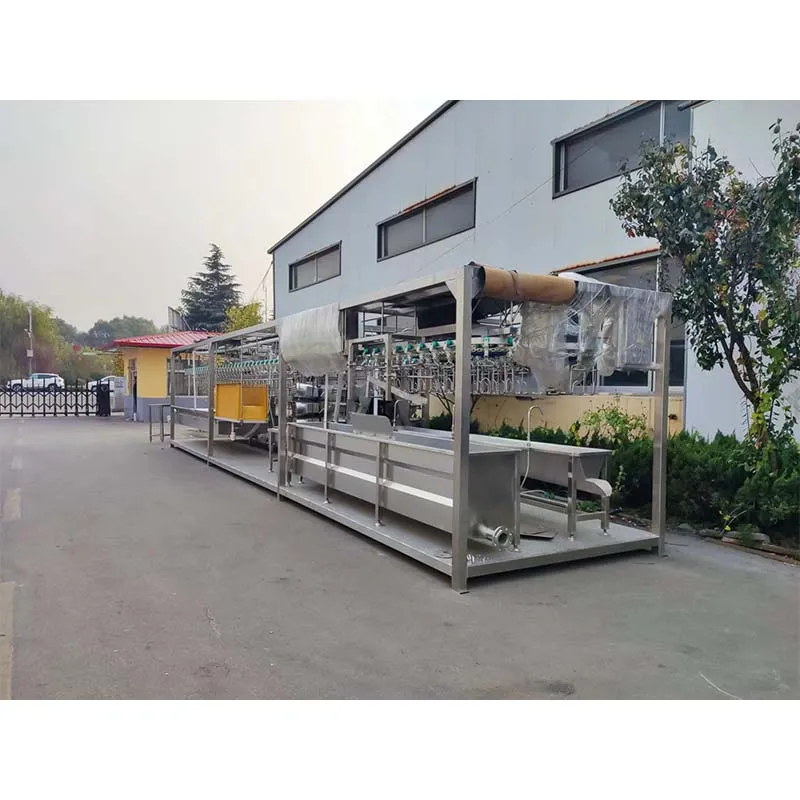Efficient Methods for Processing Chickens with Effective Scalding Techniques
Nov . 09, 2024 20:36 Back to list
Efficient Methods for Processing Chickens with Effective Scalding Techniques
The Process and Importance of Chicken Scalder in Poultry Processing
In the modern poultry processing industry, efficiency and hygiene are paramount. One of the key pieces of equipment that supports these goals is the chicken scalder. The scalder is an integral part of the processing line, serving a crucial function in the preparation of chickens for consumption.
What is Chicken Scalder?
A chicken scalder is a machine designed to immerse chickens in hot water to facilitate the removal of feathers post-slaughter. This process, known as scalding, usually takes place after the birds have been bled and plucked. The optimal temperature for scalding typically ranges from 140°F to 160°F (60°C to 71°C), depending on the type of bird and the processing requirements. The right temperature is essential because it helps loosen the feathers from the skin without cooking the meat, which can affect quality and taste.
The Scalding Process
The scalding process begins once the birds are slaughtered and bled. Afterward, they are conveyed to the scalder. The chickens move through the scalder chamber, where they are submerged in the heated water for a predetermined time—usually around 30 to 90 seconds. This time frame ensures the feathers detach effectively without compromising the integrity of the carcass.
Automated systems have made the scalding process more efficient. Modern chicken scalders often feature a continuous flow system, which allows for a more consistent temperature throughout the process. Additionally, some scalder models include features for water circulation and heating, ensuring that even the coldest spots remain at the desired temperature.
Importance of Scalding
chicken scalder

Scalding is more than just a step in the processing line; it plays a vital role in the overall quality of chicken products. Proper scalding helps ensure that feather removal is thorough, leading to a cleaner product. Inadequately scalded chickens may end up with leftover feathers, which not only affects appearance but also consumer acceptance.
Moreover, effective scalding contributes to hygiene and safety in food processing. By loosening and removing feathers, the processes that follow—such as evisceration—can be performed more cleanly. This reduces the risk of cross-contamination, which is crucial for maintaining food safety standards.
Challenges in Scalding
While scalding is essential, it is not without its challenges. One significant concern is the management of water temperature and quality. Water that is too hot can damage the bird’s skin and meat, while water that is too cool will not adequately loosen the feathers. Additionally, the water used must be regularly maintained and filtered to prevent contamination. Poor water quality can lead to microbial growth, which poses risks to food safety.
Another challenge is the energy consumption associated with heating the water. Modern scalders are designed to be energy-efficient, but ongoing costs can still be a concern for poultry processors. Finding a balance between processing efficiency and sustainability remains an ongoing challenge in the industry.
Conclusion
In conclusion, the chicken scalder is a critical component in the poultry processing sector, ensuring that chickens are properly prepared for consumption. Its role in feather removal directly impacts product quality, hygiene, and overall processing efficiency. While challenges related to temperature management and energy consumption exist, advancements in technology continue to enhance the scalding process. As the poultry industry evolves, the significance of this vital equipment will likely grow, reflecting changing consumer demands for quality and safety in the products they consume. Through innovations and improved management practices, chicken scalders will remain an indispensable element of poultry processing, catering to the needs of both processors and consumers alike.
-
Hot Sale 24 & 18 Door Rabbit Cages - Premium Breeding Solutions
NewsJul.25,2025
-
Automatic Feeding Line System Pan Feeder Nipple Drinker - Anping County Yize Metal Products Co., Ltd.
NewsJul.21,2025
-
Automatic Feeding Line System Pan Feeder Nipple Drinker - Anping County Yize Metal Products Co., Ltd.
NewsJul.21,2025
-
Automatic Feeding Line System - Anping Yize | Precision & Nipple
NewsJul.21,2025
-
Automatic Feeding Line System - Anping Yize | Precision & Nipple
NewsJul.21,2025
-
Automatic Feeding Line System-Anping County Yize Metal Products Co., Ltd.|Efficient Feed Distribution&Customized Animal Farming Solutions
NewsJul.21,2025






